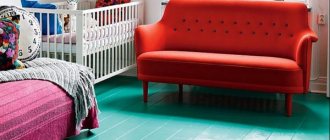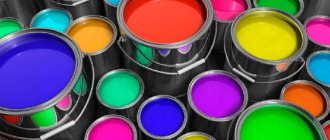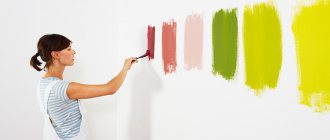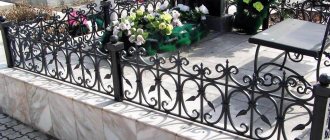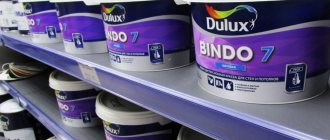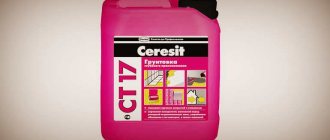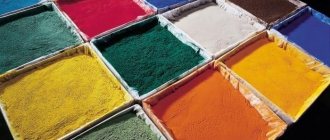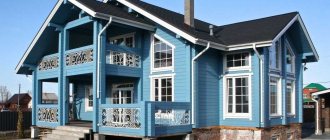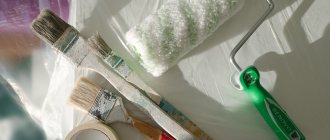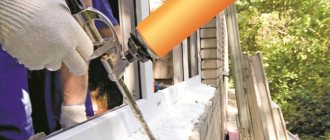Surface Features
There are a very large number of materials that are used to cover or make floors, and each option has its own characteristics, pros and cons. For example, tiles can be laid with warm floors, and linoleum is cheaper than its analogues.
Let's look at the most common types of surfaces:
- self-leveling floor;
- plywood;
- linoleum;
- cement;
- oriented strand board (OSB);
- chipboard (chipboard);
- fibreboard (fibreboard);
- tile or ceramic tiles;
- Cork tree.
Affordable oil paints
Oil dyes take longer to dry than others, about 40 hours. These materials are based on vegetable oils. Drying oil or a thinner based on white spirit in combination with turpentine are needed to dilute oil-based paints and varnishes.
The new coating gives a light, pleasant smell. But in just 5 hours it will no longer be heard, it will disappear. But there are also odorless oil formulations.
This is a dye with a modification of the polyurethane composition. Its drying speed is 5 to 6 hours. The most important advantage of the compositions is their low price compared to other paints.
The best floor paint for concrete
The composition of such a coating includes reinforcing elements that create a durable monolithic layer on concrete and improve its characteristics. The coating is easy to clean with all range of cleaning products and detergents, does not break down or peel off.
Kompozit FL-11
Wear-resistant concrete floor paint belongs to the budget category of products, since the price for a 2.8 kg container does not exceed 900 rubles.
Kompozit FL-11
The cost-effective coating is used for painting concrete flooring for industrial purposes, as well as parking lots, metal floors, etc. It is possible to use paint for concrete floors in a garage or outdoors. The product is resistant to abrasion and weathering.
Sniezka Beton-posadzka
This is an acrylic dye for self-leveling floors; it has good adhesion to the base, as well as economical consumption - up to 8 m2/l. The product is resistant to repeated cleaning and frequent rubbing.
Sniezka Beton-posadzka
The composition includes pigments, acrylic resins, fillers. Both internal and external use are allowed. The manufacturer, to obtain the specified characteristics, recommends applying the mixture in at least 2 layers. You can use a spray gun, roller, or brush. There are 7 available colors in the range. Price – 2300 rubles for 5 liters.
Oil coatings
Oil paint for floors has lost its former popularity after the emergence of a large number of other, better, compositions. It is made from drying oil, which, in addition to an unpleasant, pungent odor, has toxic properties. With prolonged contact with this substance, your health may worsen, dizziness, and migraines may appear.
It is better to use oil paint to paint the floor in a country house or garage, where the room can be well ventilated and left for several days, since this coating takes a long time to dry.
After hardening, the finishing material forms a dense protective film that does not allow moisture to pass through. The painted surface is easy to care for and tolerates wet cleaning well.
It takes a long time to dry, has a strong smell, the color is most often brown, but it is economical
The disadvantages of oil coating include:
- tendency to cracks - chips may appear under mechanical stress;
- toxicity of the main component;
- a small selection of colors - traditionally a brown tint is used.
Oil finishing materials are used for painting floors made of fiberboard, concrete, and wood. They are applied with a brush in one layer in one direction, immediately eliminating stains. If it is necessary to apply a second layer, you need to wait until the first one is completely dry.
Painting must be done in a respirator and protective clothing. Removing old oil paint from a surface is quite labor-intensive; for options on how to do this, read the article “How to remove old paint.”
Kinds
Depending on the composition, floor paints are divided into several groups:
- Oil paint. Compared to other types of floor paints, oil paint is not the best option. Although it has many of the advantages of modern coatings, it has significant disadvantages. Drying oil, which is the base, has a high viscosity, and this increases the drying time. To reduce the time it takes for such paint to completely harden, it is necessary to use a solvent that evaporates easily. Drying oil also has a certain aroma, so oil paint cannot be considered an odorless material.
- Acrylic enamel. It consists of acrylic resin and aqueous solvent, and the pigment provides color. Refers to natural eco-paints.
This composition imparts certain properties:
- Elasticity and strength.
- Water resistance.
- No odor and quick drying.
This paint can be used for painting both concrete and wooden bases. It can also be applied to an old layer of paint, but you should not do this if there are uneven spots on it. In this case, the new layer will only highlight the defects. To paint a wooden floor, the paint product is applied in several layers. And in order to reduce paint consumption before painting, it is necessary to treat the base with a primer.
- Alkyd enamel. The quality is similar to acrylic enamel and is ideal for rooms with high humidity. It is well absorbed and protects against moisture, suitable for concrete and wooden floors. But the disadvantages of this coating are significant: it has a pungent odor and is not fireproof or fireproof. Among the advantages are resistance to chemicals and the fact that the enamel is antistatic.
Alkyd enamel is more suitable for concrete coating, and for wood, the compositions PF-223, PF-253, PF-126 are distinguished.
- Polyurethane paint. Polyurethane enamel is popular due to its unusual texture, which appears after drying and resembles crushed silk. This paint has a long-lasting color, it is odorless, quick-drying, and wear-resistant. It is used to coat concrete, wood and even paving slabs. The packaging must indicate for which surfaces the paint is intended.
Disadvantages include toxicity and, under certain conditions, explosion hazard. When painting, you need to make sure that the room is well ventilated.
- Latex paint. A special feature of this paint and varnish product is its ability to cover defects and microcracks in the floor. The latex coating dries in an hour, is resistant to wear and creates a glossy shine on the floor surface. This number of advantages justifies the high cost of paint, and for cheaper types artificial rubber substitutes are added.
Advantages of painted floors
The market for construction and finishing materials has long been represented by paint and varnish products specifically designed for treating floor coverings. Moreover, the odorless floor paints sold are suitable for both wooden surfaces and ordinary concrete surfaces. The appearance of odorless coatings with a quick-drying effect made a real revolution. Advantages of coloring compositions:
- quick drying;
- safety;
- no pungent odor;
- abrasion resistance;
- color preservation;
- no sliding effect after treatment.
The problem of finding paint comes down to the question of which version of paint and varnish products is suitable in terms of properties.
Painting the floor with a brush
No. 5. Alkyd paint
Another good option for wooden floors is alkyd paints. They have excellent moisture resistance and exposure to ultraviolet rays. The basis of these paints is alkyd resins and vegetable oils, sometimes special additives are used. The group of alkyd paints includes oil and enamel paints.
oil paints were used everywhere, but now they are used quite rarely, and buyers are attracted to a greater extent by the low price of the material . It is also worth noting that oil paint can be matte or glossy; it creates an excellent barrier to the penetration of liquids and is easy to apply. The coating has more disadvantages: a pungent odor, a long drying process, a fire hazard, instability to chemicals and not the highest durability.
Enamel paints are significantly superior in performance to oil paints. They will become reliable protection for a wooden floor from all kinds of influences: moisture, sunlight, etc. After application, the material dries very quickly, the surface is wear-resistant and easy to clean. Among the disadvantages, it is necessary to note the fire hazard and toxicity during operation.
How to choose paint for different rooms
For log houses, an excellent option would be an acrylic composition that allows air to pass through and creates a reliable coating. For a nursery, it is advisable to choose paints that are easy to wash; they should be absolutely harmless.
The hallway is a place where increased loads on the flooring material are possible; acrylic and latex types will withstand them. The kitchen is subject to frequent contamination, so the ease of cleaning the base is important. For bathrooms, latex and acrylic types are chosen, which include elements against biological formations.
For a nursery, it is advisable to choose paints that are easy to wash; they should be absolutely harmless.
Best paint for wood floors
Wooden floors are used in private homes, cottages and country houses. Using boards of various sections, floor coverings are used in rooms and corridors. Beams and boards are used to create interfloor ceilings and stairs. All this needs protection, which is what wood paints are designed for. Here is a ranking of the best products in this category that you should pay attention to when choosing.
TIKKURILA BETOLUX AQUA
Rating: 4.9
The first place in the ranking is occupied by paint from a Finnish manufacturer, produced on a polyurethane-acrylate base. This gives it strength and elasticity, which helps to reliably protect the wooden floor from damage from hard objects. The paint is diluted with water, so users like it in reviews due to its ease of preparation and the absence of additional costs for the solvent. The product is produced in convenient containers from 0.9 to 18 liters.
This wood floor paint was included in the rating due to its unpretentiousness. According to the instructions, it can be applied to old varnish, epoxy or alkyd coatings. The substance adheres perfectly to old layers, does not destroy them or enter into a chemical reaction with them, which simplifies the process of preparing the surface before work. If paint is spilled on a dry floor, it can be wiped off with a weak solvent without harming the coating.
Advantages
- suitable for floors that are regularly in contact with moisture;
- diluted with water;
- 20 tinting options are provided;
- resistant to chemical attack;
- dries at 80% air humidity!
Flaws
- high price;
- for large volumes, you need to tint all the paint, otherwise it will be more difficult to choose a shade later;
- If the can freezes during storage, the paint becomes unusable.
Prestige Premium
Rating: 4.8
In second place in the ranking is floor paint from a domestic manufacturer, which also has an alkyd-polyurethane base, like the category leader, but the price of the product is much more affordable. Due to its thoughtful composition, the paint not only decorates the floor with its color, but also impregnates the wood with varnish, further protecting it from moisture. After painting with one layer, the second can be applied after 4 hours, which pleases the craftsmen in the reviews, since they don’t have to wait long. Once dry, the surface takes on a glossy appearance and looks decent. But there are few color options for floor paint - only yellow-brown shades.
Drying paint on various surfaces
The drying speed of the paint layer depends not only on the paintwork material, but also on the material of the floors being painted. Porosity reduces drying time, so wood floors will become usable faster than concrete floors. Plastic is less porous, so the lifespan increases. Surface evaporation of moisture is the key factor.
Pay attention to: Painting the ceiling: necessary materials and choice of paint, surface preparation and step-by-step instructions
Factors affecting drying time
The connection between the drying rate of the paint layer and the properties of the composition is beyond doubt. In addition, various processes occur during the curing of the painted floor. In one case this is the evaporation of volatile components, in the other an oxidation reaction. Therefore, the conditions in which the painted surface is exposed are important. The first factor is the indoor temperature. You can start moving on painted floors in a cool room later than on the same floors in a warm room. Low temperature slows down processes. The golden mean for most paints and varnishes is a temperature of 20 degrees Celsius. Another factor is the percentage of humidity in the room. High levels of humidity complicate oxidation processes, so substrates treated with water-based flooring compounds will take longer to dry. The required level of humidity is achieved and maintained through well-planned ventilation. In some cases, additional installation of an air dryer is required. The drying time of layers (especially the first) is affected by preparation. Those. A clean floor (no dust, dirt, grease stains, or damp areas) will ensure high-quality adhesion.
Temperature 20 degrees is most suitable for painting
Modern materials for interior work
Is there odorless interior paint? To be precise, there are no odorless paints and varnishes in nature; there are low-smelling ones or with a neutral odor that does not cause irritation to the mucous membranes, which means that after a short period of time it is simply no longer felt. There are plenty of such materials; you just need to choose the right specific paint for housework.
Commercially available paints for household purposes are practically odorless:
- Acrylic paints and varnishes. Some of the most popular paints and varnishes among the people are made on a water basis, and therefore have a reputation as the most harmless to the human body;
- Water-dispersible materials. The structure resembles acrylic compositions, they are also made on a water basis, but are suitable only for certain types of work, for example, for painting walls;
- Selected varieties of polyurethane and oil paints. The most complex group of materials in composition, but the range of use of polyurethane and modified oil materials is very wide.
For your information!
The water-soluble base quickly evaporates from the applied paint layer. The drying process of such paints at temperatures up to 7°C occurs twice as fast as for materials based on organic solvents. The exception is nitro paints, in which the alcohol-acetone base can dry almost on the brush, but such material always has a very pungent and strong odor. In addition, inhalation of nitro paint solvent fumes can lead to toxic poisoning.
How to determine whether there will be a smell or not
All paints have a smell, even water-soluble acrylic and water-dispersed ones. Usually, the issue of whether the paint has an odor is not checked when purchasing a material; if the seller says that acrylic paint is odorless, then it is so. Then, when applying the coating, it turns out that the smell is still present. Not as nasty, but there is a smell. It would be surprising if the quick-drying material had no odor.
When evaporating, the molecules of an aqueous or organic paint base always capture some of the binder, so no matter whether the paint is water-based or hydrocarbon-based, it will always smell. Professional painters know that after painting, even if the paint does not get on the skin of the hands, exposed parts of the body - the face and hands - should be washed thoroughly with soap, and thereby remove molecules and microparticles of paint that have got on the skin along with solvent vapors.
Another thing is that each person has his own threshold of sensitivity to odor, with a corresponding adaptation to the chemical irritant, after which even the most pungent and volatile substances are practically not perceived.
Advice! You can determine how unpleasant the smell of the purchased paint material may be. It is necessary to apply a small amount of the mixture without solvent and thinner onto glazed ceramic tiles heated to 50-60°C.
The rapid evaporation of an aqueous or organic base will immediately reveal what the real smell of the paint is. In practice, the most popular acrylic paints smell quite unpleasant when tested.
Famous manufacturers
Russian buyers have the opportunity to purchase environmentally friendly and practical products:
- international concerns Dulux and Teknos;
- Finnish company Tikkurila;
- Russian enterprise "Leningrad Paints".
World-famous manufacturers offer universal paints that fully meet customer needs and safety requirements. The range of well-known brands is so wide that it will not be difficult to choose a product for arranging premises with special operating conditions: increased vaporization, humidity, temperature changes. Products for outdoor use are frost-resistant and successfully resist the damaging effects of precipitation, ultraviolet radiation, and wind loads.
Specifics of painting with quick-drying paints
If you need to paint the base, it is advisable to equip the roller with a long handle. It will be much more convenient to work this way. It is better to purchase a roller with short nap. In addition to the roller, you will need a brush. It is convenient to paint corners of the room and hard-to-reach places.
Before you start painting, you need to read the manufacturer's recommendations. Painting of a concrete base can only be done if its temperature exceeds 500. In this case, the air temperature must be above 100C. As for humidity, it should not exceed 80%.
Each subsequent layer is applied only after the previous one has completely dried. It is worth understanding that the drying time of paint and varnish products depends on external factors. Therefore, before you start using the room, you need to make sure that the floors are completely dry.
Wooden floors must be treated with drying oil and primer before painting. After the soil has dried, defects, if any, should be repaired with a special putty. Then, you need to walk over the surface of the wooden boards with sandpaper. It is advisable to first go over with coarse-grained sandpaper, and then with fine-grained sandpaper.
The resulting surface will not have any flaws. All putty areas must be treated with primer again. This will not only strengthen the base, but also reduce the consumption of paint and varnish products. All that remains is to paint the base. The paint product should be applied in a thin layer.
